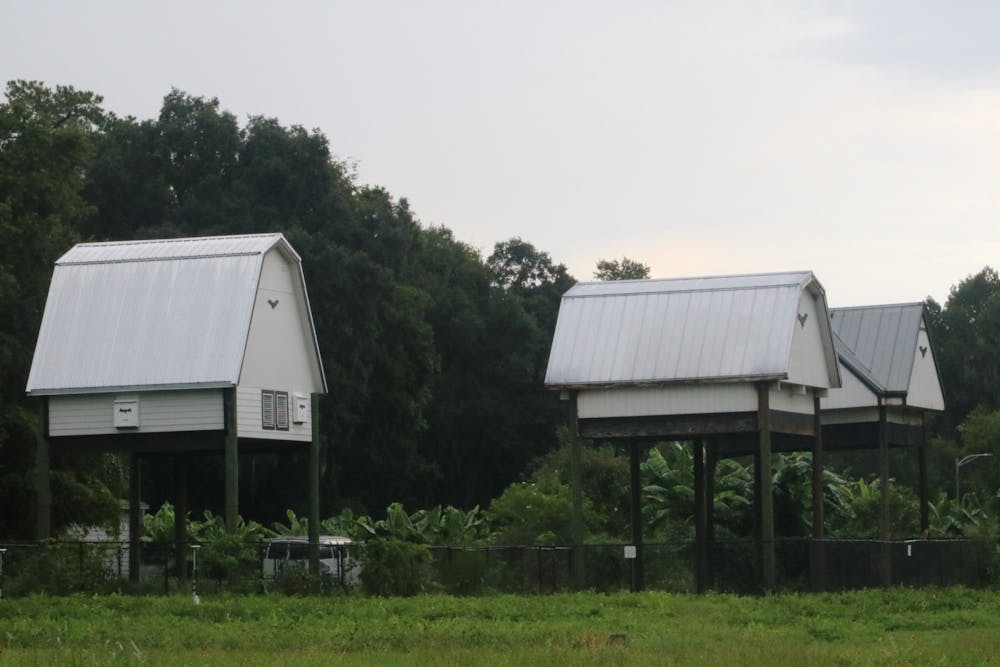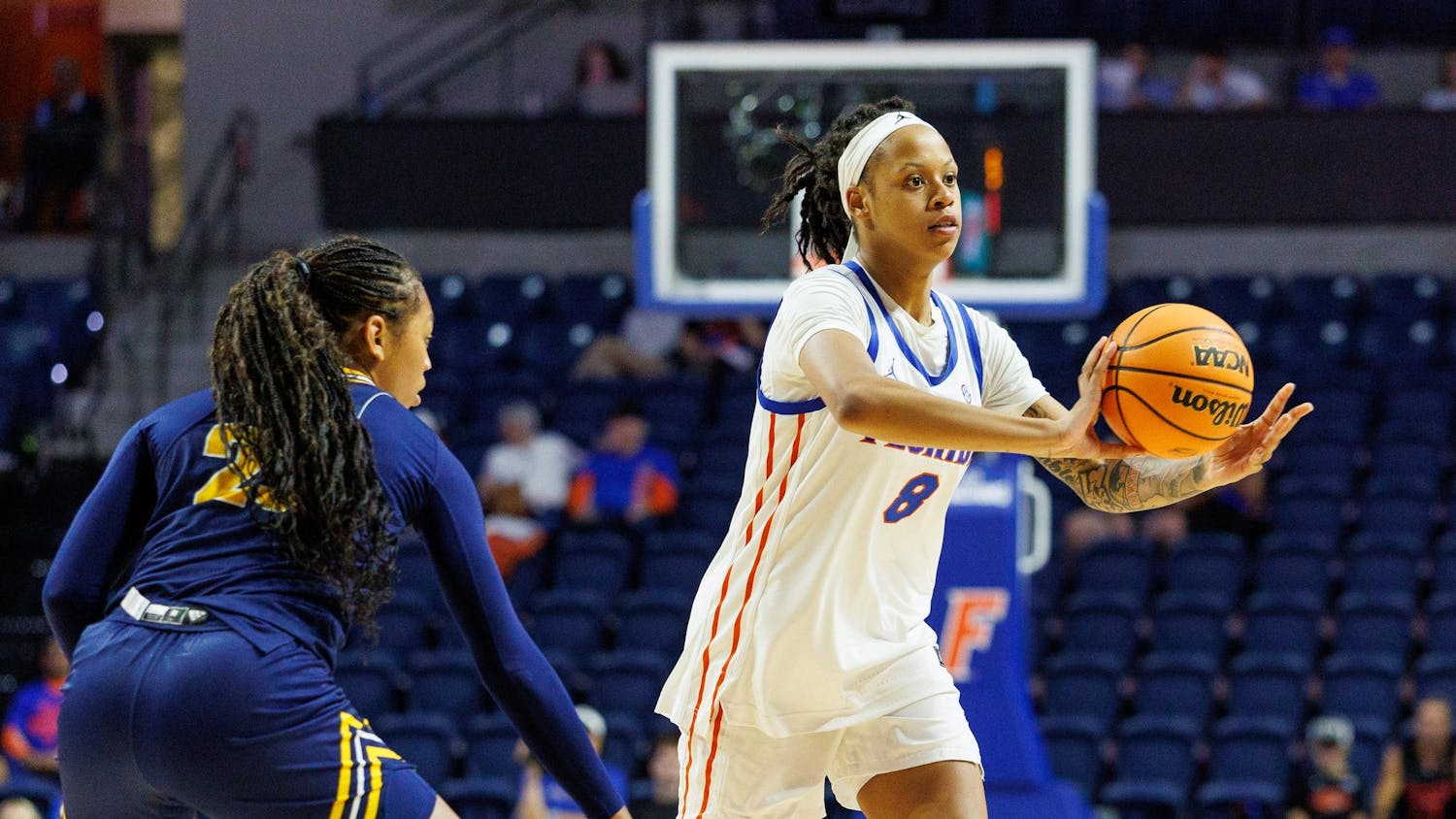Chris Carlson, UF associate director of facility support, pointed excitedly at dark mounds of guano — bat poop — on the ground below one of UF’s bat houses at Field and Fork Farm and Gardens.
“This is breaking news,” he said.
This particular house, House 3, had been empty since it was built in 2017. There are two other houses that are currently occupied by a colony of bats estimated to have numbers peaking around half a million.
UF’s bat colony is the largest in the world that lives in bat houses, according to the Florida Museum website. The houses are designed to hold around 750,000 bats.
That wasn’t a problem until this summer, when Anna Prizzia, Hitchcock Field and Fork program director and Alachua County commissioner, discovered that House 1, built in 1991, was falling apart. At first, staff attempted to repair it, Carlson said.
But the urine and guano from the bats kept eating away at the older sections of wood, Carlson said. Two sections of House 1’s bottom have fallen in, and a newly added support beam props up one of the walls.
Shelly Johnson, UF Institute of Food and Agricultural Sciences state specialized agent in natural resources, said a hurricane or tornado could knock it down soon. In the midst of hurricane season, which ranges from June 1 to Nov. 30, House 1’s state presents a real danger.
But the bats don’t know that.
So a UF team of conservationists, biologists and construction workers has taken on the task of convincing part of the colony to move into a house it’s ignored up until now, Johnson said.
Rehoming them isn’t as easy as just picking them up and moving them to House 3, Johnson said. Aside from the fact there could be hundreds of thousands inside House 1, she said bats also have the freedom to make their homes where they want.
“What people don’t always get is that the bats have to want to move,” Johnson said. “They have little brains of their own and little wings of their own. They decide where they want to go.”
It would be ideal to tear House 1 down and rebuild, Carlson said, but they can’t do that until the bats move to House 3.
However, Carlson said he estimates more than 1,000 bats have moved into House 3 as of Thursday afternoon. It makes up a small fraction of the colony, he said.
Convincing bats that moving is in their best interest isn’t a simple task.
“We’re making progress,” Carlson said.
If the group of bats in House 1 doesn’t move out before it collapses, there’s a possibility they could make new homes in other UF structures, Johnson said.
She also said that Brazilian free-tailed bats — the species that makes up the majority of the colony — can fit into spaces an inch wide. This means that they could crawl into attics, gutters and other small spaces across campus, she said.
“We don’t want the bats to move into another building where they wouldn’t be very welcome,” Johnson said.
Verity Mathis, Florida Museum mammals collections manager, is the museum representative consulted by the UF team working on the issue. She said that her concern is the bats moving into someplace that could be problematic, like the football stadium.
“That is everyone’s biggest fear,” Mathis said. “We’re trying to avoid that.”
Originally, she said, the bat colony lived in the UF Percy Beard Track and Field Stadium in the 1980s. Building House 1 in 1991 was an attempt at a kind of pest control, which took three years. At the time, there was a combined effort of repelling the bats from the stadium and physically taking them to House 1.
Now, the bats are studied by professors and graduate students. Their guano is used to fertilize the Field and Fork gardens surrounding the bat houses. And every night, around 15 minutes past dusk, nearly half a million bats fly out for the night to hunt, a spectacle that students and Gainesville residents have come to watch for years.
Some of those bat researchers are Johnson and UF graduate assistant Caitlin Campbell, who Carlson said he’ll meet with in coming weeks to discuss the best way to move forward to make the bats as comfortable as possible.
Recently, Carlson and his construction team added a landing board and a long piece of plywood inside a corner of House 3 to provide more space for the bats to crawl inside. No one can be sure what caused the bats to move in Thursday, he said, but he and Bradley Files, UF pest management coordinator, have discussed putting in more landing boards in the rest of the house.
Carlson said they have also considered roughening the wood inside the house to make it easier for bats to grip.
Another technique they have tried has been adding guano inside and below the house during the past few years it’s been empty, but both Carlson and Johnson said experts don’t agree on whether that actually works.
Carlson said they’ve improved the house’s ventilation to create ideal temperatures inside, and they’ve removed some obstacles like long beams to protect the bats from predators. It makes landing for the bats easier too.
Carlson also said they might try a tactic called an exclusion, where they would block off parts of the house over time each night when the bats fly out. Eventually, the bats wouldn’t be able to come back and they’d be forced to look for homes elsewhere. However, they can’t be sure that will work until they are certain the bats are moving into House 3, Carlson said.
The time and resources it has taken to aid the bats with their move paid off on Thursday, Carlson said. He also said that once the bats settle in, they can start making plans to rebuild House 1 so the colony can grow even more.
“They’re an iconic part of the campus here,” he said. “It feels good to know they’re going to stay.”
Contact Siena at sduncan@alligator.org. Follow her on Twitter @SienaDuncan.

Siena Duncan is the Fall 2024 Editor-in-Chief of the Alligator. She's interned for the Salt Lake Tribune, the Tampa Bay Times and POLITICO. In her spare time, she loves to take walks to see the cows by her apartment and add more to her sketchbook.






